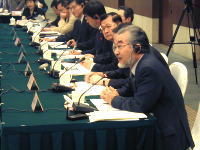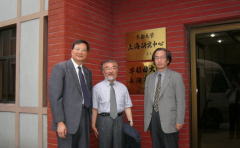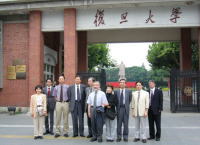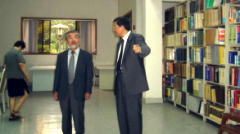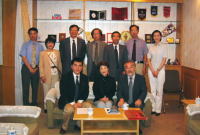Kazuo OIKE
I participated in various activities during the two-day conference held in Beijing from August 1st to 3rd at the historic Beijing Hotel.
At 9 am on the 2nd, Mr. Xu Zhihong, President of Peking University, delivered the opening address in which he introduced Mr. Zhou Ji, Chinese Minister of Education. He explained in detail how higher education reform is rapidly progressing in his country and explained to us the 2 areas of strategic significance, 6 important projects and another 6 key measures all part of a new plan to be realized by 2007.
The first area of strategic importance is rural education, where plans for establishing a 9-year compulsory education system throughout western China and constructing high-level universities as the second area are underway. He clearly indicated where he would like China to move with respect to improving its innovative capabilities and international competitiveness.
Then, a report on Japanese issues was presided over by Dr. Tsuyoshi Sasaki, President of Tokyo University. Mr. Shinji Kondo, Deputy Minister of the Ministry of Education, Culture, Sports, Science and Technology on the national university corporations, delivered a speech.
One of the great advantages of attending conferences outside Japan is being able to hear first hand from the Deputy Minister himself about the progress of educational reform or, statements such as "I believe the reorganization of our universities will greatly progress in the future", about the overall mindset of the Ministry of Education, Culture, Sports, Science and Technology. Deputy Minister Kondo touched upon interrelations between Japanese and Chinese universities with respect to exchange students as well as the past results of academic exchanges. He spoke of a policy where highly talented exchange students will be vigorously sought after in the future as one of the most important issues in this area.
Mr. Motoyuki Ono, President of the Japan Society for the Promotion of Science delivered his report after greeting the crowd in Chinese. That institution, which plays a very significant role in Japan-China academic exchanges, recently opened a new office in Beijing. Mr. Ono explained that most of the Society's 200 billion yen funds would be allocated as a competitive fund and pointed out the significance and the system. He concluded by speaking about the "10 Competences" demanded of all the presidents of Japan's universities. At that moment, I found myself exchanging a glance with Mr. Sasaki seated at the presenter's table and gave a bitter smile at the thought of that statement. Mr. Xu, also at the presenter's table also had a good laugh.
After the coffee break, the next session of the conference began with a report by Mr. Wang Shenghong, President of Fudan University, on Japan-China interchanges. He spoke of his institution's agreement with Waseda University, which includes the awarding of degrees, and about Kyoto University's Shanghai Research Center. He evaluated the merits of human resource exchanges in a wide range of fields, listed several areas of concern with respect to exchange students and proposed the establishment of a scholarship system. The report given by Mr. Pan Yunhe, President of Zhejiang University, began with a few words about the 1st Conference of Directors of Japan and China Universities that was held at Tokyo University. He spoke of the present progress of university reform in China and of the lively controversy in regards to the system by which universities are evaluated, adding that one of the essential points of the debate is trying to find the right balance between education and research.
Next, the Japanese side made some remarks, presided over by Mr. Takashi Yoshimoto, President of Tohoku University who spoke a bit about his institution. I then stepped up to speak about Kyoto University's reorganization into the national university corporation. I went on to say that, historically, Japan's university and doctorate system was initially borrowed from the Chinese over a thousand years ago, and now, as iterated in Professor Zhou's report which left a deep impression on me, we have the golden opportunity to learn from the rapid reform efforts that are now in progress in China. Next, I commented on the great leaps forward that have occurred in the area of Japan-China academic exchanges since the restoration of diplomatic ties between the two countries. I then expressed my deep appreciation for having had the opportunity to attend the conference, and gave a synopsis on the issue of converting national universities into corporations from the perspective of one university, in response to the reports given by Deputy Minister Kondo and President. Ono.
The histories of all modern national universities in Japan have a common link to the founding of Tokyo University in 1877 and of Kyoto University in 1897. After the Pacific War, the great reforms of the mid-20th Century saw the introduction of a new university system. The next great reform is the reform of national universities into corporations. Details have already been given, however, I spoke in specific terms of Kyoto University as one such reorganization. The reform of the Japanese national university system, one hundred years in the making, is an endeavor of great proportions that requires the uneasy task of combining the efforts of all universities.
Concerning competitive funding, I explained the need to clarify the process with respect to integrated university expense allocations per instructor, competitive funds between individuals and groups for scientific research, and also competition among universities with respect to the 21st Century COE Program. I concluded by saying that while many Chinese students are studying in Japan, I too would hope that there could be a greater mutual exchange of highly talented students.
Many questions followed pertaining to faculty remunerations, the university president's authority over staff members, determination on tuition fees, the president's selection procedure, etc. Mr. Sasaki then asked a few questions to the Chinese participants to discuss the exchange student system, and Mr. Katsuhiko Shirai, President of Waseda University, shared his views on the academic degree system and other matters.
President. Pan Yunhe, asked a few questions relating to specialized subjects, and he shared his opinion on the fusion of the arts and sciences as well as on the system of changing majors. The Chinese then hit the panelists with a barrage of specific questions including: How will the board of executive directors be organized? With respect to administrative costs, what about the need for a tax system reform in the area of contributions? What will be the relationship between the faculty, after becoming non-governmental officials, and the Ministry of Education, Culture, Sports, Science and Technology? How will the 6-year tenure for faculty be evaluated? How will basic research be evaluated?
Deputy Director Kondo answered simply and added his desire to see continued reform efforts especially in the area of preferential treatment with respect to the taxation system. He explained that personnel issues are particularly troublesome and much time should be set aside to determine how those exchanges are to proceed.

Mr. Ono, President of the Japan Society for the Promotion of Science, speaking at the fellowship gathering of the Conference of Directors of Japan and China Universities
During the afternoon break Mr. Liu Xing of Peking University television station as well as Mr. Tang Jingli of the China Education News interviewed me. At my lunch table, I conversed about international exchanges with Mr. Sahei Hayashi, Director of the Japan-China Friendship Association.
The first speaker of the afternoon session was Dr. Gu Binglin, President of Tsinghua University, who expressed his desire to explore possible courses in English, tuition fees, credits and degrees for programs. Also, he proposed that programs of the 21st Century COE Program be conducted jointly. In 1994, Nanking University was selected for the "China's 211 Project". Now, it boasts academic exchange agreements with 21 Japanese universities. Mr. He Jicheng, President of Northeastern University in China reported about the comprehensive exchange programs between his institution and Tohoku University in Japan.
I recognized the importance of a plan for English education for the sake of internationalization. However, because of the exchange between China and Japan during the past century in the fields of biology, medical science and earth sciences, I stated my view for the need to promote our "Kanji" culture. Many participants seemed to be of the same opinion.
With Dr. Hideo Miyahara, of Osaka University, presiding, Mr. Senri Kajiyama, President of Kyushu University, reported on the fusion of sensitivity and the general sciences that occurred due to his institution's merger with Kyushu Institute of Design. Several statements were then heard from Mr. Toshiro Tanaka, Managing Director of Keio University, on behalf of Mr. Yuichiro Anzai, President, along with Mr. Hou Zixing, newly appointed President of Nankai University, Mr. Shinichi Hirano, President of Nagoya University, Mr. Xie Shengwu, President of Shanghai Jiao Tong University and Mr. Katuhiko Shirai, President of Waseda University.
Mr. Jin Onishi, Vice-President of Tohoku University proposed that all members of this Conference of Directors of Japanese and Chinese Universities should standardize their efforts to cooperate in order to cut out the duplication of labor, and increase efficiency.
President. Miyahara, spoke of the need for implementing a scholarship and entrance examination system along with language programs. Waseda University's newly established department with all lectures given in English is helping that institution learn new things. A Chinese person attending lectures in the U.S. said, he would not get the same cultural exposure as someone who is taking lectures in English at a Japanese institution.
Deliberations continued on into the last session with Mr. Xie saying that exchanges between university presidents is important, however, what is even more important is using these same channels to further the exchange between researchers. Then President. Hirano, enthusiastically recounted the progress his institution, Nagoya University, is making, followed by Mr. Shirai, who made the comment that an individual who studied at only one department of only one university probably is not fully prepared for participation in the global society of tomorrow. We learned also that plans for joint research and education programs are now underway at the Peking University-Waseda University Educational Scientific Research Center. This is a sharp indication that the number of Waseda students desiring to study in China is increasing. There are also plans to promote further cooperation in the agreement between Suzhou City and Waseda University.
Mr. Seiichi Washida, Vice-President of Osaka University, iterated that cooperation is just as important as competition. Agreeing with this point, Mr. Qingshi Zhu, President of the University of Science and Technology of China told of the importance of Eastern culture and of multiculturalism. He mentioned the wisdom of a household in Anhui Province as an example, and stated his desire to take the excellence of Asian culture into consideration to contribute to a sustainable society. He also stated his opinion that there exists a thought contrary to the Western thought of "eliminating people who do not support your idea".
Mr. Sasaki and Mr. Xu concluded the session. Mr. Sasaki especially insisted on a heated discussion concerning the need to enhance the quality of exchange students and said that much consideration needs to be focused on government-financed foreign exchange students by everyone including the embassies. Also, he iterated the need to foster a human resource that deeply understands East Asia with a particular awareness towards its cultural society. Mr. Zhang Xinsheng, Vice Minister of the Ministry of Education, Republic of China, delivered the closing speech and the conference came to an end.
Following the conference, I visited Tsinghua University on the 3rd of August, and was given the opportunity to see the office of Mr. Gu, President of the university, which is truly a beautiful old building constructed several hundred years ago, giving me a deep feeling of its historical significance. I noticed that the name "Zhang Heng", of the Later Han Period, appears at the entrance of the Physics Department and was very astonished at the large size of the student dormitory complex.
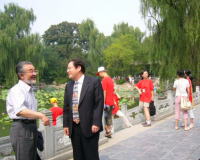 |
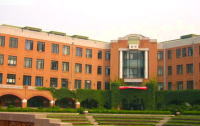 |
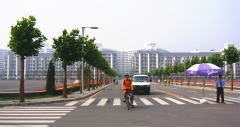 |
| With Mr. Gu, President of Tsinghua University, in front of his office |
In a physics classroom at Tsinghua University | Outdoor lecture square at the Tsinghua University dormitory |
I went on to Shanghai and, on the 4th, visited Kyoto University's Shanghai Center located within Fudan University, where I was given a tour of the campus. There is presently a stupendous rush to complete buildings in time for the University's 100th Anniversary. I was shown many things by Mr. Zeng Xian Ming and Mr. Naohiro Kitano of the Shanghai Center, Mr. Zai Xiao Fu and Mr. Fan Youngming of Fudan University's Center for Japanese Studies, Professor Yumi Yamamoto, who was my chaperon throughout the tour, and especially Mr. Yan Shuang, Vice-Secretary of Fudan University, who, being a 30-something executive full of youth and vigor, explained certain things in elaborate detail.
At the official residence of Mr. Nobuyuki Sugimoto, Consul General of the Japanese Consulate in Shanghai, Mr. Fan Yuntao had gathered Kyoto University alumni who waited to welcome us until late at night for our itinerary to finish. There, I treated everyone to a slideshow explaining recent happenings at Kyoto University, which pleased everyone, especially the Consul General. We then sang a well-known song about Lake Biwa and had a great evening.
In passing, in a Beijing magazine, I saw an advertisement for the Tokyo University, Waseda University and Osaka University Alumni Associations. I left China with the strong feeling we should have our own Alumni Association at Kyoto University to help our alumni, active in different parts of the globe, come together.


